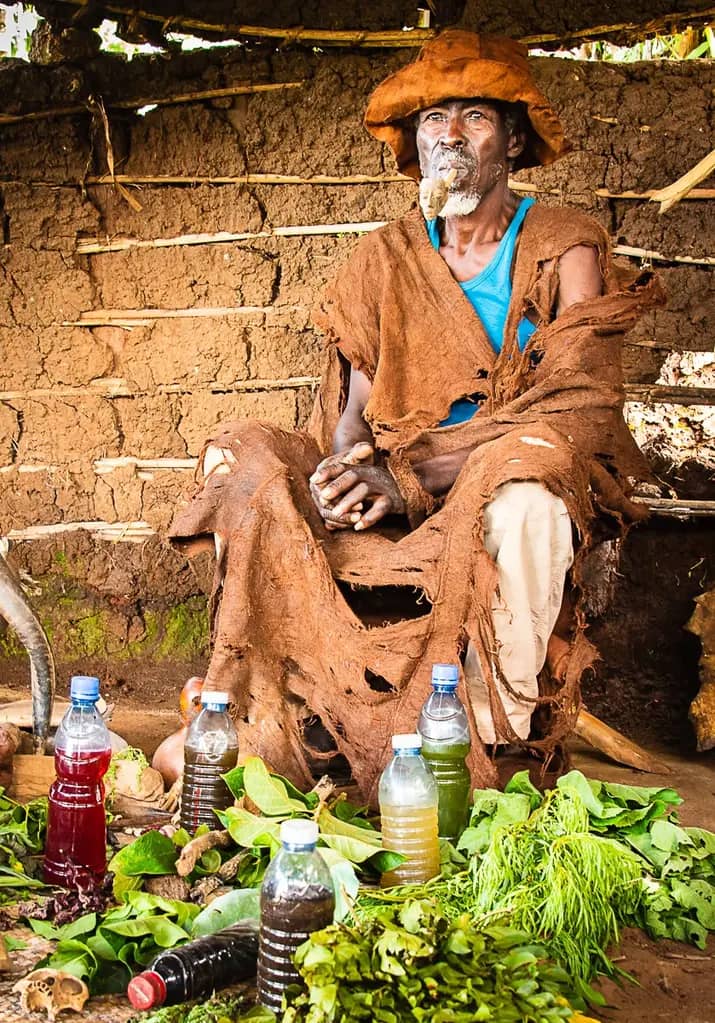My very first memories of “Njaga” as cannabis is known in Uganda was back in the mid 90’s where at the slightest cough an infusion would be made from fresh Njaga plant as the main ingredient and administered as both a tea and a poultice. I carried this remedy in my heart, made through my adolescent years though I made a few tweaks along the way. Cannabis usage has been part and parcel of the Uganda culture for centuries,. A visit to the Muammar Gaddafi Museum in Central Kampala one would notice on display various hookah style pipes with a tribe/ethnic group written under each pipe.
I would later learn that the pipe is called “Mindi” and the usE of it is far from recreational and is considered to be very sacred and forms part of the shaman’s divination tools. Shamans in Uganda use cannabis to communicate with spiritual entities to exorcise or channel them. It is mixed with wild sage and tobacco and smoked prior to commencing rituals. Cannabis makes you aware of the spirits in and around you and that has been the belief in rural Uganda among traditional and spiritual healing circles. It is widely believed that if one smokes the Njaga without permission from the ancestors, insanity will follow instantly.
The spiritual channeling process as carried by the Kharamoja tribe, who are direct descedents of the Masai of present Kenya involves a shaman smoking the mindi filled with cannabis, sage and tobacco till he reaches a trance-like state. It is at that point that he starts to dance in circles and his voice would somehow deepen with lion roar-like “sounds”. The villagers would come and kneel before the Shaman and he would start blessing them with words and if there are any sick individuals, he would encircle them and command the spirit allowing the sickness to leave the body all under the guidance of the Njaga. The conjurations and divinations are performed by the shaman and he allows the sick to ‘rest` in his shrine surrounded by food, alcohol and fruit offerings.
Tradition would time and again remind the youth that Njaga was never meant to be smoked for fun but for spiritual and physical healing. It was the mushrooming of ghettoes on the peripheries of urban centres that recreational njaga smoking became a normality. From Lake Kyoga to Lake Bunyonyi on the south west and all the way to Lake Victoria on the East and its vast islands cannabis has found perfect home as lake shore crop.
The journey starts here and ends in the dusty streets of various sub economic densely populated slums. Smokers each with his own reason for flirting with “insanity”. The Rastafarians who blame their habits on the movement, manual farm workers who use it as a sundown relaxant after a hard day at work then another group of alcoholics who use cannabis to boost their intoxication levels and it wouldn’t be surprising to meet students who use it for concentration while studying.
The rainfall pattern, proximity to water sources and the fact that Uganda falls on the Equator allows for cannabis to be cultivated all year round which ensures a constant supply to all demand segments. Any cannabis plant grown in the tropical forest of Uganda goes into bloom 20 days after emergence. The genetics considered “local” should be almost knee-high at that point with males being slightly taller. The trees would then quadruple in size through the bloom period which lasts between 16 to 22 weeks but local growers prefer to harvest the plants earlier to avoid rain and humidity. Nonetheless it does not affect potency that much. Throughout this process it only receives nothing but water with very isolated cases of intentional fertilisation program, mostly human urine, cow manure and crop waste.
Myth has it that amongst the local growers potency is increased by the presence of a green mamba snake within the grower’s field. The green mamba is considered the guardian of the Njaga fields and the strongest Njaga is associated with the mamba, and tokers alike would make jokes about how one has been bitten by a mamba referring to someone who is feeling really high.The genetics of the Uganda landraces are believed to have been brought by Arabs who were trading ivory in the Congo as most genetics concentration is along the ancient Arab trade routes from Mombasa to the Congo basin. The Ugandan most likely shares an ancestry with the Ethiopian Highland Sativa commonly known as the Shashamane and also a descent with the Red Congo.
Over the years the Uganda has evolved to an almost unique plant physiologically owing to mutations of growing in a tropical rain forest for several centuries. The first mutation being the leaf structure. In a bid to survive bud rot the Uganda has developed very thin leaves with as many 13 leaflets to almost one leaflet at the peak of bloom.
This has helped the Ugandan plants to survive continuous heavy rains and the humidity that follows. The buds under these conditions automatically turn into a cluster of foxtails with very dense sticky nuggets. The tropical rain has also evolved the Uganda into a hardy plant that can withstand overwatering and temperature extremes.
The tall wide trees have withstood the test of time and they need plenty of room to perform optimally hence why you will find growers just having a handful of these plants in their backyard. The smell of the Uganda is very unique and can make one immediately forget about the not so inviting appearance. The pinesol, turpentine, fermented citrus, fruits and deep floral aromas with a nose bending feel and a lingering half sneeze. The more you grind it the stronger each terpene gets, but all blended into one confusing aroma no matter how bad the plant was cultivated, with the ‘mamba’ being the gassiest.
